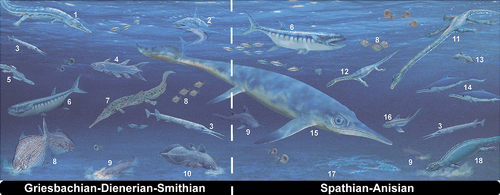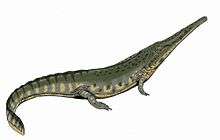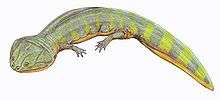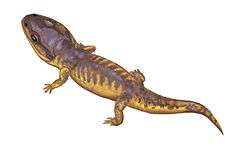Aphaneramma
Aphaneramma is an extinct genus of temnospondyl amphibian. It lived during the Early Triassic epoch. Fossils have been found in the Mianwali Formation of Pakistan, Madagascar, the Zhitkov Formation of Russia,[2] and the Kongressfjellet Formation of Svalbard (Norway). Aphaneramma grew up to 2 metres (6.6 ft) long, with a 23 centimetres (9.1 in) skull. Aphaneramma's jaws were very long, similar to the gharial's, and lined with small teeth. This adaptation suggests it may have preyed on fish. A marine lifestyle for this animal was proposed.[3] Aphaneramma is closely related to Cosgriffius from North America,

Early Triassic and Anisian marine predators[4]: 7. Aphaneramma
| Aphaneramma | |
|---|---|
 | |
| Scientific classification | |
| Kingdom: | Animalia |
| Phylum: | Chordata |
| Order: | †Temnospondyli |
| Suborder: | †Stereospondyli |
| Family: | †Trematosauridae |
| Subfamily: | †Lonchorhynchinae |
| Genus: | †Aphaneramma Woodward, 1904[1] |
References
- A. S. Woodward. 1904. On two new labyrinthodont skulls of the genera Capitosaurus and Aphaneramma. Proceedings of the Zoological Society of London 1904:170-176
- Zhitkov Formation at Fossilworks.org
- Scheyer, Torsten M.; Romano, Carlo; Jenks, Jim; Bucher, Hugo (19 March 2014). "Early Triassic Marine Biotic Recovery: The Predators' Perspective". PLoS ONE. 9 (3): e88987. Bibcode:2014PLoSO...988987S. doi:10.1371/journal.pone.0088987. PMC 3960099. PMID 24647136.
- Scheyer et al. (2014): Early Triassic Marine Biotic Recovery: The Predators' Perspective. PLoS ONE https://doi.org/10.1371/journal.pone.0088987
This article is issued from Wikipedia. The text is licensed under Creative Commons - Attribution - Sharealike. Additional terms may apply for the media files.



